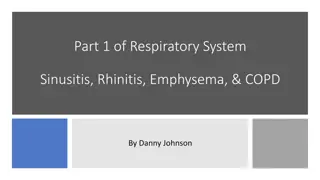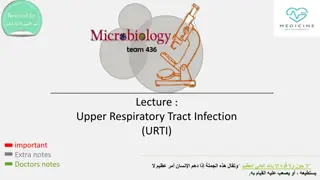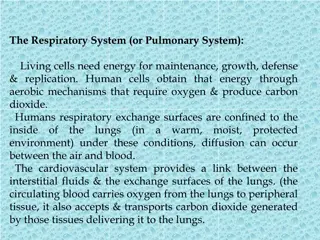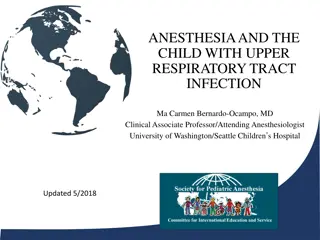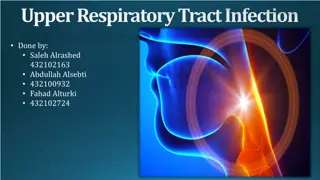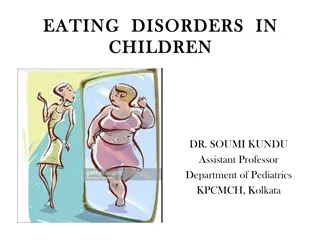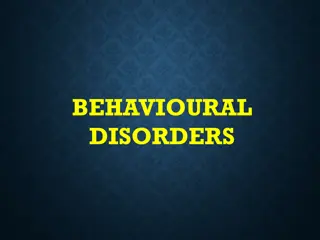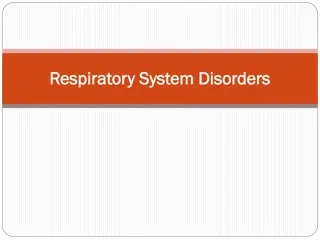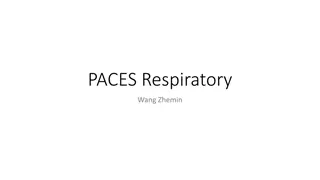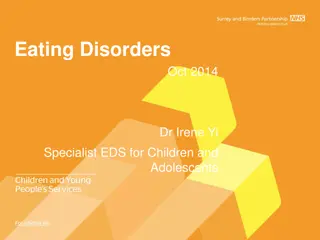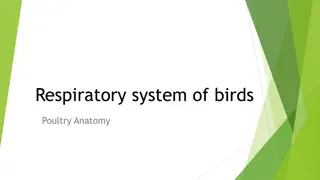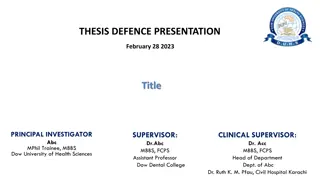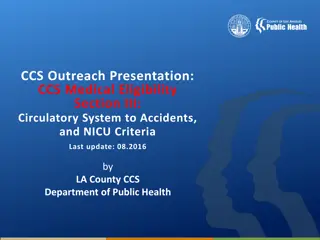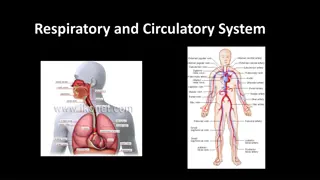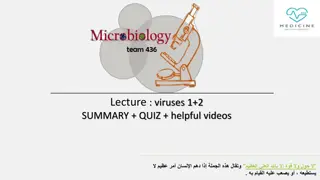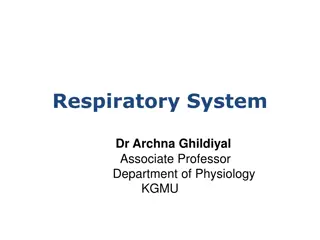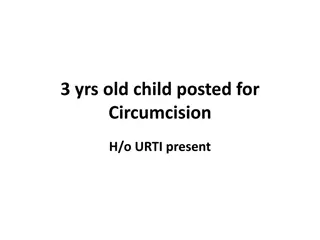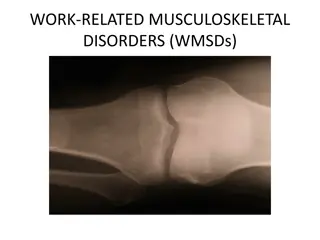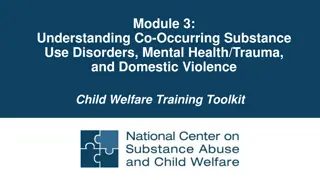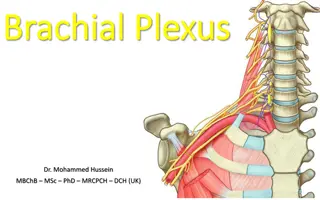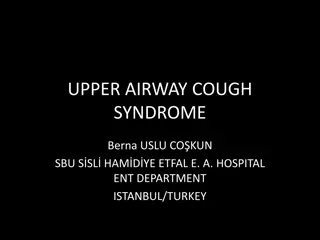Understanding Upper Respiratory System Disorders in Children
Anatomy of the child's respiratory tract, common cold (acute nasopharyngitis), clinical manifestations, treatment and nursing care are discussed in detail, emphasizing the importance of differentiating between various childhood contagious diseases and allergic rhinitis. The content highlights the symptoms, care, and management strategies for children with upper respiratory system disorders. Images and insights shared by Lecturer Assistant Kareem AL-Khafajy add depth to the educational material.
Uploaded on Sep 13, 2024 | 0 Views
Download Presentation

Please find below an Image/Link to download the presentation.
The content on the website is provided AS IS for your information and personal use only. It may not be sold, licensed, or shared on other websites without obtaining consent from the author. Download presentation by click this link. If you encounter any issues during the download, it is possible that the publisher has removed the file from their server.
E N D
Presentation Transcript
Upper Respiratory System Disorder Lecturer Assistant Kareem AL-Khafajy
Anatomy of the childs respiratory tract The respiratory system is made up of the nose, pharynx, larynx, trachea, epiglottis, bronchi, bronchioles, and the lungs. 2
ACUTE NASOPHARYNGITIS (COMMON COLD) The common cold is one of the most common infectious conditions of childhood. The young infant is as susceptible as the older child but generally is not exposed as frequently. The illness is of viral origin such as rhinoviruses, Coxsackie virus, respiratory syncytial virus (RSV), 4
Clinical Manifestations The child older than the age of 3 months usually develops fever early in the course of the infection, often as high as (38.9_C to 40_C). The child sneezes and becomes irritable and restless. 5
The congested nasal passages can Interfere with sucking, increasing the infant s irritability. Because the older child can mouth breathe, nasal congestion is not as great a concern as in the infant. The child might have vomiting or diarrhea, which might be caused by mucous drainage into the digestive system. Kareem AL-Khafajy
This nasopharyngeal condition might Appear as the first symptom of many childhood contagious diseases, such as measles, and must be observed carefully. The common cold also needs to be differentiated from allergic rhinitis. Kareem AL-Khafajy
Treatment and Nursing Care The child with an uncomplicated cold may not need any treatment in addition to Rest. increased fluids and adequate nutrition, normal saline nose drops, suction with a bulb syringe, humidified environment. In the older child, paracetamol or children s ibuprofen can be administered as an analgesic and antipyretic. 8
Cont. Treatment and Nursing Care Aspirin is best avoided. If the nares or upper lip become irritated, cold cream or petrolatum (Vaseline) can be used. The child needs to be comforted by holding, rocking, and soothing. If the symptoms persist for several days the child must be seen by a physician to rule out complications such as otitis media. 9
TONSILLITIS AND ADENOIDITIS Lymphoid tissue normally enlarges progressively in childhood between the ages of 2 and 10 years and shrinks during preadolescence. If the tissue itself becomes a site of acute or chronic infection, it may become hypertrophied and can interfere with breathing, may cause partial deafness, or may become a source of infection in itself. 10
Tonsillitis refers to infection and inflammation of the palatine tonsils. Adenitis refers to infection and Inflammation of the adenoid (pharyngeal) tonsils. Tonsillitis is a common illness in childhood resulting from pharyngitis. A ring of lymphoid tissue encircles the pharynx, forming a protective barrier against upper respiratory infection. This ring consists of groups of lymphoid tonsils, including: Kareem AL-Khafajy
1- palatine tonsils are located on both sides of the pharynx. 2- Adenoids tonsils are located in the nasopharynx cavity. 3-Tubal tonsils are located at the entrance to the Eustachian tubes. 4- Lingual tonsils are located at the base of the tongue. Kareem AL-Khafajy
Clinical Manifestations and Diagnosis The child with tonsillitis may have a fever of (38.4_C) or more. Sore throat, often with dysphagia (difficulty swallowing) Hypertrophied tonsils Erythema of the soft palate. Exudates may be visible on the tonsils. The symptoms vary somewhat with the causative organism. Throat cultures are performed to diagnose tonsillitis and the causative organism. Frequently the cause of tonsillitis is viral, although etahemolytic streptococcal infection also may be the cause. 16
Treatment and Nursing Care Medical treatment of tonsillitis Consists of: 1. analgesics for pain 2. antipyretics for fever, 3. antibiotic in the case of streptococcal infection. A standard 10-day course of antibiotics is recommended. 4. tress the importance of completing the full prescription of antibiotic to ensure that the streptococcal infection is eliminated. 18
5. A soft or liquid diet is easier to swallow, 6. The child should be encouraged to Maintain good fluid intake. 7. A cool-mist vaporizer may be used to ease respirations. 8. Tonsillectomies generally are not performed unless other measures are ineffective or the tonsils are so hypertrophied that breathing and eating are difficult. 9. Tonsillectomies are not performed while the tonsils are infected. 19
Adenoidectomy and Tonsillectomy Treatment and Nursing Care The adenoids are more susceptible to chronic infection. An indication for adenoidectomy is hypertrophy of the tissue to the extent of impairing hearing or interfering with breathing. Performing only an adenoidectomy if the tonsil tissue appears to be healthy is an increasingly common practice. Tonsillectomy is postponed until after the age of 4 or 5 years, except in the rare instance when it appears urgently needed. Often when a child has reached the acceptable age, the apparent need for the tonsillectomy has disappeared. Kareem AL-Khafajy
PREOPERATIVE ASSESSMENT preoperative preparation, include: complete blood count, bleeding and clotting time, urinalysis, Psychological preparation is often accomplished through preadmission orientation play-nurse material helps the child develop security. The amount and the timing of preparation before admission depend on the child s age. The child may become frightened about losing a body part. Telling the child that the troublesome tonsils are going to be fixed is a much better choice than saying that they are going to be taken out. 21
Ask about any bleeding tendencies because postoperative bleeding is a concern. Carefully explain all procedures to the child and be sensitive to the child s apprehension. Take and record vital signs to establish a baseline for postoperative monitoring. The temperature is an important part of the data collection to determine Observe the child for loose teeth that could cause a problem during administration of anesthesia Document findings 22
Nursing Process for the Child Having a Tonsillectomy NURSING DIAGNOSES 1. Risk for Aspiration postoperatively related to impaired swallowing and bleeding at the operative site 2. Acute Pain related to surgical procedure 3. Deficient Fluid Volume related to inadequate oral intake secondary to painful swallowing 4. Deficient Knowledge related to caregivers understanding of post discharge home care and signs and symptoms of complications 23
PLANNING The major postoperative goals for the child include: 1. Preventing aspiration. 2. Relieving pain, especially while swallowing 3. Improving fluid intake. 4. The major goal for the family is to increase knowledge and understanding of post discharge care and possible complications. 24
IMPLEMENTATION Preventing Aspiration Postoperatively Immediately after a tonsillectomy, place the child in a prone position with head turned to one side until the child is completely awake. Encourage the child to expectorate all secretions Discourage the child from coughing. Check vital signs every 10 to 15 minutes until the child is fully awake, and then check every 30 minutes to 1 hour. Hemorrhage is the most common complication of a tonsillectomy. Bleeding is most often a concern within the first 24 hours after surgery and the 5th to 7th postoperative day. 25
Indications of bleeding during the 24 hours after surgery: observe, document, and report any unusual restlessness anxiety, frequent swallowing, or rapid pulse that may indicate bleeding. Vomiting dark, old blood may be expected, but bright, red flecked emesis or oozing indicates fresh bleeding. Observe the pharynx with a flashlight each time vital signs are checked. Bleeding can occur when the clots dissolve between the 5th and 7th postoperative days if new tissue is not yet present. or due to infection 26


